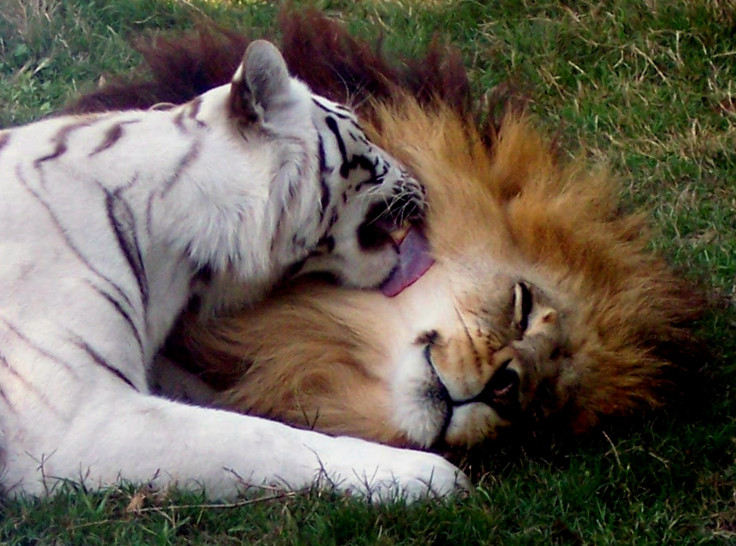Ligers, tigons and liligers: All you need to know about big cat hybrids and why breeding them isn't a great idea
Ligers are the offspring of female tigers and male lions.
In January 2017, a Russian zoo made the headlines with the birth of a liger cub named Tzar – a cute hybrid cat born to a female tiger and a male lion. The excitement generated by the news worldwide proved once more that people are fascinated by these rare, exotic big cat hybrids.
While ligers and tigons (the same hybrid, but with a lioness and a tiger) are undeniably cute, it's worth noting that these animals only occur in captivity.
Many conservationists have recently condemned the breeding of lions and tigers as unethical, saying that it does not help wildlife in any way.
What are the most common big cat hybrids?
Big cat hybrids remain quite rare around the world, which is part of the reason they attract so much attention. The most common big cat hybrid is the liger (lion father and tiger mother), while tigons (lion mother and tiger father) seem to be more rare.
"For some reasons, people are very interested in ligers. They are often captivated by tigers, so the fact that a tiger mother has been bearing a hybrid sounds appealing. We have never been called to rescue a tigon", Susan Bass, Director of Public Relations at Big Cat Rescue told IBTimes UK.
That being said, it is very hard to estimate how many ligers and tigons exists worldwide, for the simple reason that there isn't anyone tracking these cats.
Known cases of ligers are mostly recorded in zoos in the US (where Hercules, the biggest liger alive is found) and in China. It is possible that many private owners in the US also have big cat hybrids in their homes but to date, no precise figure exists to describe the phenomenon.
Can ligers and tigons be found in the wild?
Tigons and ligers are always born in captivity. One of the reasons is geography – lions and tigers currently don't co-occur in the wild any more. Lions live mostly in Africa today, and tigers are found in Asia. More importantly, these animals are from the same genus but not from the same species, so they would not naturally interbreed.
"Even when tigers and lions did overlap in the past, there is no record of them mating and producing hybrids in the wild. Tigers and lions have diverged millions of years ago, they last had a common ancestor an estimated 2-4 M years ago. So even though it is physiologically possible for them to mate, they are two separate species, reproductively isolated", Dr. Luke Hunter, President and Chief Conservation Officer for Panthera, the global wild cat conservation organisation told IBTimes UK.

These hybrids are born when lions and tigers are kept together in captivity and end up mating. "In captivity cats will mate with whoever they are in the same enclosure with. If you a zoo owner who purposely keeps females tigers with his unneutered male lion, then they will mate and probably have babies as was the case in Russia recently", Bass said.
Why are ligers and tigons bred?
Even though breeding sometimes occurs by accident, the main reason lions and tigers are bred is that there is a financial incentive for owners. These animals are unusual and so they are desirable – people will pay to see them or hold the cubs.
It's one of the reasons why Big Cat Rescue and other organisations are in fact pushing for a federal bill in the US banning the public from being in contact with cubs.
"We believe a lot of the breeders continue to breed cubs just so they can get money from them by having people hold the cubs when they are small and manageable. However, they outgrow that cuteness and become more dangerous when they are about 12 weeks old. They can live to be 20 years old in captivity, so essentially breeders are raising them for a very short shelf life when they are profitable and then they become a liability", Bass explained.
Are ligers sterile?
As is the case with most hybrids, male ligers and tigons are almost always sterile. Female ligers can however have cubs – and some breeders have recently bred them with lions to create "liligers".
What other health problems do ligers suffer from?
The lack of data and monitoring makes it hard to document all the health defects that can result of the hybridisation of big cats. Nevertheless, a number of problems have often been reported, including birth defects and the fact that these felines tend not to live as long as tigers and lions in captivity.

Ligers are also the largest extant felines. Hercules, the largest of them all weighs between 900 and 1000 pounds (roughly 400-450 kg). This massive size can take a toll on the animal's organs. It can also cause problems for the female tigers who bear the babies, as tiger cubs are usually a lot smaller. It is not uncommon for a tiger mother to die while giving birth to the large liger cubs.
Is there really a conservation argument for breeding these animals?
Some breeders argue that they are producing ligers and tigons for conservation purpose. They say that they are mixing lions and tigers to preserve their genetic material and that holding liger cubs can make people start caring for the animals – and thus embrace conservation.
But experts are not convinced. "Breeding ligers and tigons does absolutely nothing for conservation. When you breed them you are actually diluting their genetic material. There is also very little evidence that keeping these cats in captivity creates consensus around conservation", Hunter said.
Furthermore, tigons and ligers will be born and raised in captivity, with no chance of ever being introduced into the wild.
Even if they were sent into the wild, they would probably not be able to survive on their own. Some people argue that breeding these animals destined to a life in captivity – where they might not be cared for properly by incompetent owners – is quite cruel.
What can you do?
Everyone can play a role in fighting the practice of breeding lions and tigers. In the US, not buying big cats or paying to hold cubs – whether lions, tigers or ligers – is a first step. You can also support accredited institutions that work to promote wildlife conservation – and are not breeding animals for commercial reasons.
© Copyright IBTimes 2024. All rights reserved.






